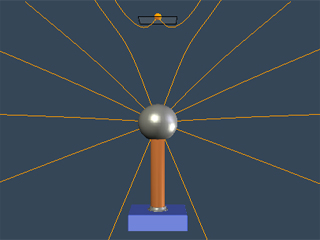| DESCRIPTION:
This applet shows the charging of a Van de Graff Generator
to a positive potential when there is a stationary positive
charge sitting above it (resting on a plastic square).
The presence of that charge means that we have to do
more work than normal to charge up the generator. If
the positive charge above the generator has charge q
and the generator has radius a and is charged to a total
charge Q, the energy we must put in to charge up the
generator is:

This total amount of energy is stored in the electrostatic
field surrounding the generator after it is charged.
As we charge it, there is a Poynting flux outward from
the region where we are creating electromagnetic energy.
This region is where the charge is being moved against
the electric field on the conveyer belt (inside the
cylindrical shaft of the generator). This region is
where the creation rate per unit volume for electromagnetic
energy (-J dot E), is positive. Energy is created there
and flows out to fill the space around the generator.
This energy flow can be seen in the motion of the electric
field lines, which always move in the direction of the
Poynting flux.
Pressing "Start" after charging the generator
releases the stationary positive charge sitting above
the generator. If there is enough electrostatic repulsion
to overcome gravity, that charge will move upward. We
can see that the source of its increasing kinetic energy
and gravitational potential energy is the electrostatic
field, because again we see the flow of energy out of
that field, as indicated by the motion of the electric
field lines. Since we have no energy dissipation in
the system, the charged particle will eventually come
to rest at some distance above the generator, and then
start to fall back, transferring gravitational potential
energy and kinetic energy back into the electrostatic
field, as shown by the field line motion.
The graph shows the energy stored in the electrostatic
field (not including the self energy term proportional
to Q^2) and the sum of the gravitational potential energy
and the kinetic energy of the charge. The sum of these
is the total energy of the charge: gravitational potential,
plus electrostatic potential, plus kinetic energy, and
is constant as long as we keep Q constant.
|


